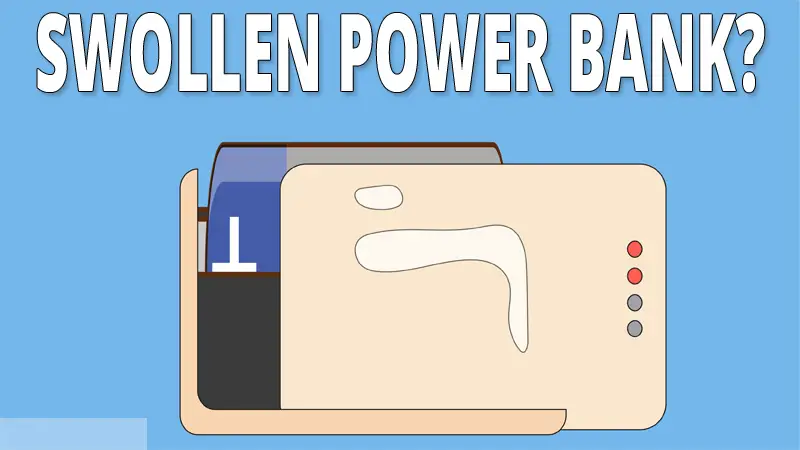While it doesn’t happen very often, sometimes power banks do swell. If that’s your case, then you must be wondering why?
Power banks usually have lithium batteries. These types of batteries are known to swell if you overcharge or if they are stored in a hot area. Sometimes power banks also swell if you don’t use them for a long period of time.
But, what should you do if the power bank is swollen? Can you still use it? We have explained everything you need down below.
Contents
Why Does a Power Bank Swell?
The number one reason a power bank swells (or bloats) is because of overcharging or undercharging of the battery. When you overcharge a power bank the electrolytes of the battery break down. These electrolytes contain organic solvents that break down to oxygen and cause the battery to bloat.
Another reason for the power bank swell can be the battery itself. Power banks come with lithium batteries that have a certain number of charging cycles (usually 500). After 500 charging cycles the battery starts to weaken and that can lead to overcharging or overheating of the battery.
Overcharging lithium batteries will increase the current (I) of the cell and that causes gas and heat to build up. The gas takes more volume and makes the whole battery larger.
Sometimes, power banks also get swollen if you don’t use them for a long period of time, or if you store them in a hot temperature area. That’s why it’s recommended to check the power banks from time to time.
That’s why it’s recommended to buy high-quality power banks from trusted brands. These power banks come with in-built circuits that prevent the battery from overcharging.
Can You Use a Swollen Power Bank?
You should never use a power bank or battery that has swollen. The battery has generated gas inside and charging it could lead to a catastrophic failure. The power bank can explode, generate smoke and flames, or damage your phone.
If you charge a bloated power bank then the charge could increase the pressure of gas and that can lead to fire or leaked chemicals. It’s best to properly recycle the battery and get a new one.
You should never try to open or puncture the battery to get rid of the gas. A swollen lithium battery is very vulnerable and it should be avoided.
In some rare cases, the battery loses its swell and gets back to normal size. But, that shouldn’t fool you. Once the battery swells there’s no turning back, it’s permanently damaged. Even if you decide to use the power bank (which you shouldn’t), the battery charging capacity will be so low it wouldn’t even charge your phone above 40%.
Technically, you can fix a swollen power bank if you replace the swollen battery. However, in most cases, the replacement costs more than buying a new one. So, it’s best to buy a new one.
What Should You Do With a Swollen Power Bank?
If you are not an electrician you shouldn’t try to open or fix the swollen power bank. If you want to fix it, it’s best to send it to a local electronics repair.
If you don’t want to fix it, then you should recycle it. In most states, rechargeable batteries are considered “hazard waste” which means you can’t throw them in the regular trash. Different electric retail stores have bins in front of their store that accepts electric devices (including power banks) for proper disposal, free of charge.
There are also different companies that offer “mail-in” where you can mail the power bank to their address and they will properly recycle it, the service is free of charge. Or, you can send the power bank to a “hazard waste” facility and they will recycle it, free of charge.
How To Prevent Swollen Power Bank?
While sometimes the battery just bloats without a reasons, the are a few things you can do to prevent having a swollen power bank:
- Buy a power bank from a trusted brand – The most important thing to do when buying a power bank is to check its brand. Power banks from trusted brands tend to last longer. The reason behind this is that these power banks come with protective circuits that prevent the power bank to overcharge or overheat.
- Don’t leave your power bank plugged in all the time – The job of lithium batteries is to cycle (discharge and charge), if you keep the battery plugged in all the time you will prevent the discharge process which could lead to a damaged battery. You should remove the charger once the power bank is fully charged.
- Use an original charger – Sometimes the original charger gets lost or doesn’t work anymore so we replace it with a cheaper one. The cheaper charger may not have the same power output and that can damage the battery.
- Store the power bank in a dry and cool environment – You should store the battery in a cool and dry area. Hot temperatures and humidity will damage your power bank battery by stressing the cells.
- If the battery is underperforming, replace it – If you had the power bank for a few years and you notice that it isn’t performing as well as it should, then you have to replace it. All batteries will eventually fail, so it’s best to avoid that.
